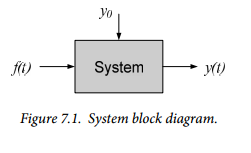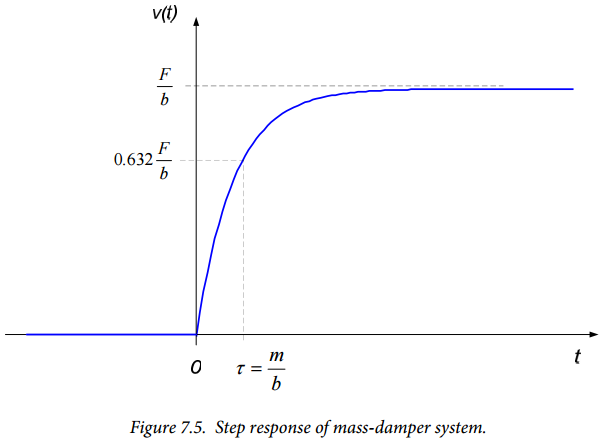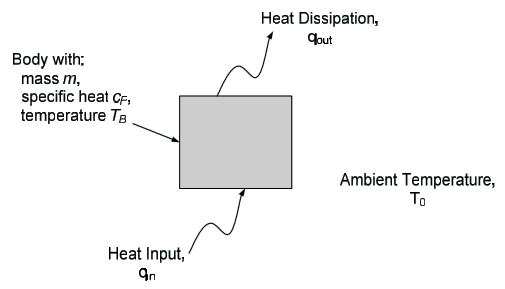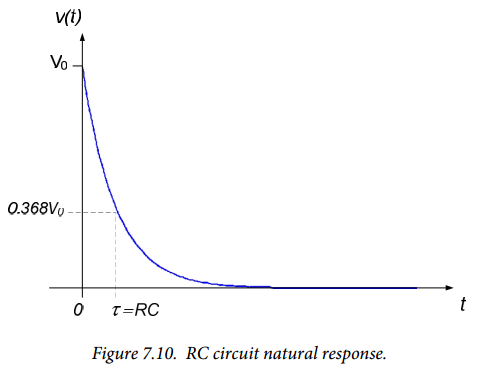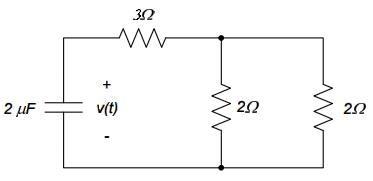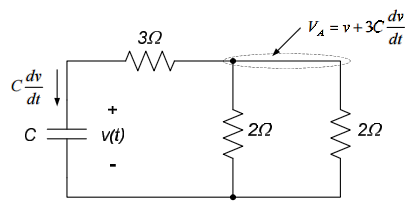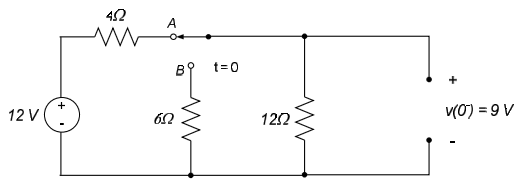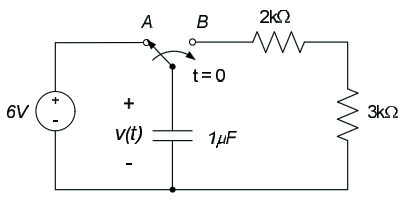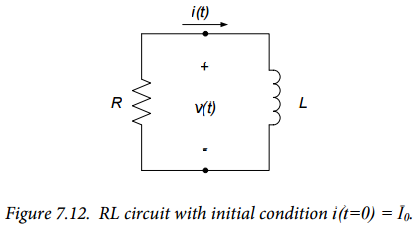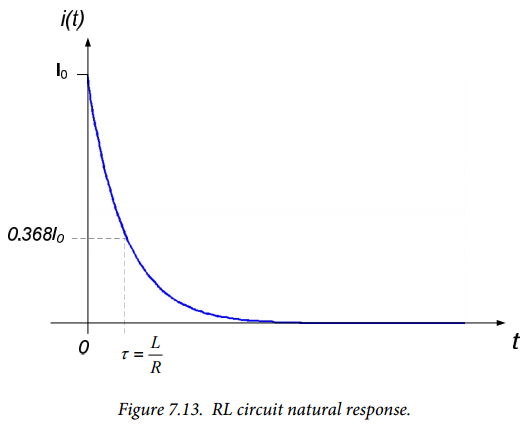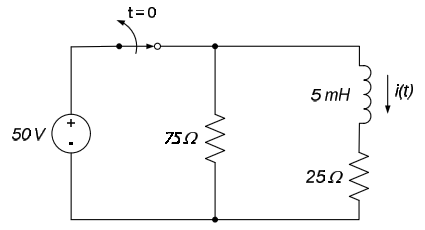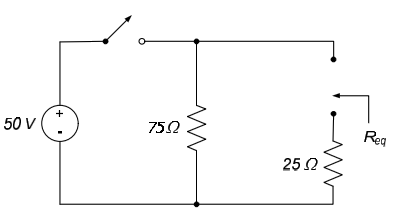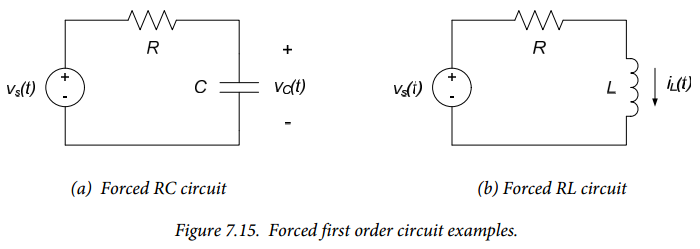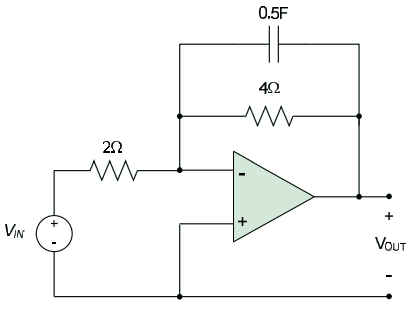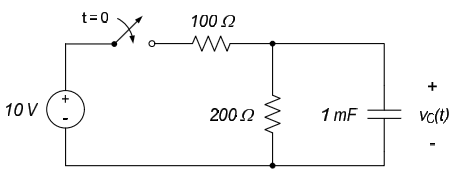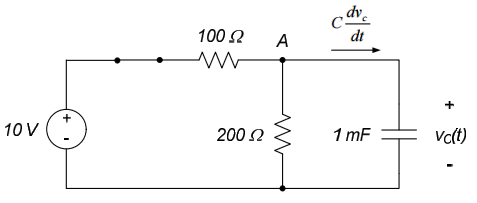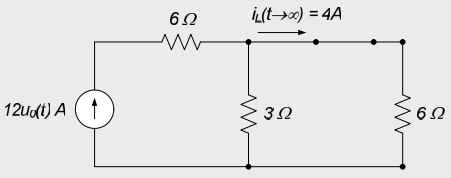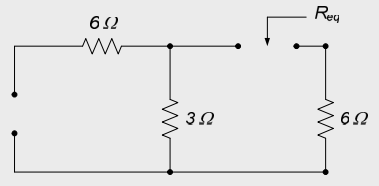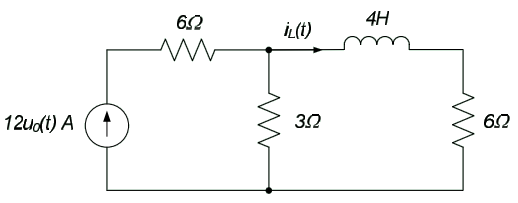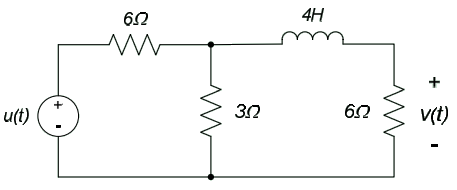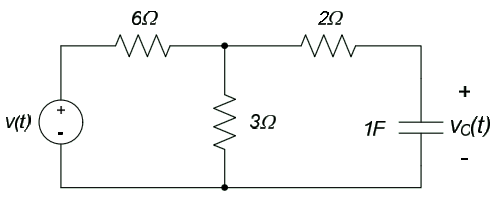Real Analog: Chapter 7
- Chapter 7 Materials
-
- Lecture Material:
- Lecture 16(b) PowerPoint Slides: Inductors, introduction to first-order circuits, RC circuit natural response
- Lecture 17 PowerPoint Slides: RL circuit natural response, general first-order system natural response, first-order circuit examples
- Lecture 18 PowerPoint Slides: Forced response of first-order circuits, active first-order system examples, step response of first-order circuits
- Lecture 19 PowerPoint Slides: Steady-state response & DC gain, step response examples
- Lecture 20 PowerPoint Slides: First-order circuit step response, introduction to second-order systems
- Chapter 7 Videos:
- Lab 7 Video 1: RC Circuit Natural Response: We create an RC circuit natural response in two ways: by (1) converting the source to an open circuit and (2) converting the source to a short-circuit.
- Lab 7 Video 2: RC Circuit Forced Response: The step responses of both passive and active first-order RC circuits are measured. Loading effects on the two circuits are examined.
-
-
- Exercise Solutions: Chapter 7 exercise solutions
- Homework: Chapter 7 homework problems
7. Introduction and Chapter Objectives
First order systems are, by definition, systems whose input-output relationship is a first order differential equation. A first order differential equation contains a first order derivative but no derivative higher than first order – the order of a differential equation is the order of the highest order derivative present in the equation.
First order systems contain a single energy storage element. In general, the order of the input-output differential equation will be the same as the number of independent energy storage elements in the system. Independent energy storage cannot be combined with other energy storage elements to form a single equivalent energy storage element. For example, we previously learned that two capacitors in parallel can be modeled as a single equivalent capacitor – therefore, a parallel combination of two capacitors forms a single independent energy storage element.
First order systems are an extremely important class of systems. Many practical systems are first order; for example, the mass-damper system and the mass heating examples from section 6.1 are both first order systems. Higher order systems can often be approximated as first order systems to a reasonable degree of accuracy if they have a dominant first order mode. (System modes will be discussed later in this text.) Understanding first order systems and their responses is an important aspect to design and analysis of systems in general.
First order electrical circuits are a special class of first order systems – they are first order systems which are composed of electrical components. Since the electrical components which store energy are capacitors and inductors, first order circuits will contain either one (equivalent) capacitor or one (equivalent) inductor.
In this textbook, we are really interested only in the analysis of electrical circuits, so the bulk of this chapter, of course, deals with analysis of first order electrical circuits. However, at this stage of your studies, you probably do not have an intuitive grasp of the mechanisms of energy storage in electrical circuits and the response of electrical circuits with energy storage elements. Therefore, this chapter begins in Section 7.1 with a general discussion of the response of first order systems, using a sliding mass as an example within which to frame the basic concepts. This provides a relatively gentle introduction to the nomenclature and mathematics which will be used throughout this chapter, in the context of an example for which the student should have some physical insight. Section 7.1 can be omitted, however, without loss of clarity of the remaining sections. Sections 7.2 and 7.3 present the natural response of RC and RL circuits, respectively (RC circuits have a capacitor as an energy storage element, while RL circuits contain an inductor). The natural response of a system corresponds to the system response to some initial condition, with no forcing function provided to the system. In section 7.4, we present the force response of first order circuits, and in section 7.5 we examine the response of first order circuits to a specific forcing function – a step input.
After Completing this Chapter, You Should be Able to:
- Write the general form of the differential equation governing a first order system
- State, in physical terms, the significance of a differential equation’s homogeneous and particular solutions
- Define, from memory, the relationships between a system’s unforced response, zero-input response, natural response, and the homogeneous solution to the differential equation governing the system
- Define, from memory, the relationships between a system’s forced response, zero-state response, and the particular solution to the differential equation governing the system
- Determine the time constant of a first order system from the differential equation governing the system
- Write mathematical expressions from memory, giving the form of the natural and step responses of a first order system
- Sketch the natural response of a first order system from the differential equation governing the system and the system’s initial condition
- Sketch the step response of a first order system from the differential equation governing the system and the amplitude of the input step function
- Write the differential equation governing RC and RL circuits
- Determine the time constant of RC and RL circuits from their governing differential equations
- Determine the time constant of RC and RL circuits directly from the circuits themselves
- Determine initial conditions on arbitrary RC and RL circuits
- Write from memory the form of the natural responses of RC and RL circuits
- Determine the natural response of RC and RL circuits, given the governing differential equation and initial conditions
- Write the form of the differential equations governing forced first order electrical circuits
- Determine the time constant of a forced electrical circuit from the governing differential equation
- Write differential equations governing passive and active first order circuits
- Determine the differential equation governing the step response of a first order electrical circuit
- Write the form of the particular solution of a first order differential equation, to a step input
- Write the form of the step response of a first order electrical circuit
- Determine the final conditions (steady-state response) of a first order electrical circuit, to a step input
- Define DC gain for a circuit and relate it to the steady-state response to a step input
- Determine the step response of a first order electrical circuit from the governing differential equation, the initial conditions, and the final conditions
7.1: Introduction to First Order Systems
In this section, we introduce some basic nomenclature relative to first order system responses and illustrate these terms in the context of an example for which the reader may have an intuitive understanding: a mass sliding on a surface. This example, though not directly relevant to the study of electrical circuits, is intended to allow the reader to develop some physical insight into the terminology and concepts relative to the solution of first order differential equations. The concepts and results obtained with this example are then generalized to apply to any arbitrary first order system. These results are used in later sections to provide insight in the analysis of electrical circuits, for which the reader may not yet have an intuitive understanding.
Before discussing first-order electrical systems specifically, we will introduce the response of general first order systems. A general first order system is governed by a differential equation of the form:
$$a_1 \frac{dy(t)}{dt} + a_0 y(t) = f(t), t>t_0 (Eq. 7.1)$$
Where $f(t)$ is the (known) input to the system and $y(t)$ is the response of the system. $a_1$ and $a_0$ are constants specific to the system being analyzed. We assume in equation (7.1) that the input function is applied only for times $t>t_0$. Thus, from equation (7.1), we can only determine the response of the system for times $t>t_0$.
In order to find the solution to equation (7.1), we require knowledge of the system’s initial condition:
$$y(t=t_0) = y_0 (Eq. 7.2)$$
The initial condition, $y_0$, defines the state of the system at time $t=t_0$. Since equation (7.1) describes a system which stores energy, the effect of the initial condition is to provide information as to the amount of energy stored in the system at time $t=t_0$.
The system described by equations (7.1) and (7.2) can be illustrated in block diagram form as shown in Figure 7.1. The output of the system depends upon the initial condition, $y_0$, and the input function $f(t)$. The initial condition provides information relative to the energy stored in the system prior to application of the input function. The input function provides information relative to the energy being applied to the system from external sources. The input-output equation describes how the system transfers the energy initially present in the system and the energy added to the system to the system output.
The solution to equation (7.1) consists of two parts – the homogeneous solution, $y_h (t)$, and the particular solution, $y_p (t)$, as shown below:
$$y(t) = y_h(t) + y_p(t) (Eq. 7.3)$$
The homogeneous solution is due to the properties of the system and the initial conditions applied to the system; it describes the response of the system if no input is applied to the system, so $f(t) = 0$. The homogeneous solution is sometimes called the systems natural response, the unforced response, or the zero input response. Since all physical systems dissipate energy (according to the second law of Thermodynamics) the homogeneous solution must die out with time; thus, $y_h(t) \rightarrow 0$ as $t \rightarrow \infty$.
The particular solution describes the systems response to the particular forcing function applied to the system; the form of the particular solution is dictated by the form of the forcing function applied to the system. The particular solution is also called the forced response or the zero state response.
Since we are concerned only with linear systems, superposition principles are applicable, and the overall system response is the sum of the homogeneous and particular solutions. Thus, equation (7.3) provides the system’s overall response to both initial conditions and the particular forcing function being applied to the system.
The previous concepts are rather abstract, so we provide below an example of the application of the above concepts to a system for whose response the students should have some intuitive expectations. This example is intended to provide some physical insight into the concepts presented above prior to applying these concepts to electrical systems.
Mass-damper System Example
As an example of a system which includes energy storage elements we revisit the mass-damper system of section 6.1. The system under consideration is shown in Figure 7.2. The applied force $F(t)$ pushes the mass to the right. The mass’s velocity is $v(t)$. The mass slides on a surface with sliding coefficient of friction $b$, which induces a force which opposes the mass’s motion. The mass will have some initial velocity:
$$v(t=0)=v_0 (Eq. 7.4)$$
Consistent with section 6.1, we consider the applied force to be the input to our system and the mass’s velocity to be the output. Figure 7.3 illustrates the system input-output relationship and initial conditions in block diagram form.
The governing equation for the system was determined in section 4.1 to be the first order differential equation:
$$m \frac{dv(t)}{dt} + bv(t) = F(t) (Eq. 7.5)$$
We consider two cases of specific forcing functions in the following cases. In the first case, the forcing function is zero, and we determine the system’s natural response or the homogeneous solution to equation (7.5) above. In the second case, the forcing function is a constant nonzero force applied to the mass with zero initial velocity.
Case i: Natural (Homogeneous) Response
Let us consider first the case in which the mass has some initial velocity but no external force is applied to the mass. Intuitively, we expect that the velocity of the mass will decrease until the mass comes to rest. In this example, we will determine the solution of the differential equation (7.5) and compare this solution with our expectations.
With no applied forcing function, the differential equation governing the system is:
$$m\frac{dv(t)}{dt} + bv(t) = 0 (Eq. 7.6)$$
The initial condition is given by equation (7.4) above, repeated here for convenience:
$$v(t=0) = v_0$$
Equation (7.6) is a homogeneous differential equation, since there is no forcing function applied to the system. Thus, the particular solution in this case is $y_p(t) = 0$ and our overall solution is simply the homogeneous solution, $y(t) = y_h(t)$.
To solve the above differential equation, we rearrange equation (7.6) to give:
$$\frac{m}{b} \cdot \frac{dv(t)}{dt} = -v(t) (Eq. 7.7)$$
Separating variables in equation (7.7) results in:
$$\frac{dv(t)}{v} = - \frac{b}{m}dt (Eq. 7.8)$$
Incorporating dummy variables of integration and integrating both sides of (7.8) gives:
$$\int_{v_0}^{v(t)} \frac{d\xi(t)}{\xi} = - \frac{b}{m} \int_{0}^{t} d\zeta$$
Which evaluates to:
$$ln(v) |_{v_0}^{v(t)} = - \frac{b}{m} t \Rightarrow ln [v(t)] - ln [v_0] = - \frac{b}{m} t \Rightarrow ln \left[ \frac{v(t)}{v_0} \right] = - \frac{b}{m}t$$
Taking the exponent of both sides of the above provides our final result:
$$v(t) = v_0e^\frac{-bt}{m} (Eq. 7.9)$$
A plot of the response given in equation (7.9) is shown in Figure 7.4. This plot matches our previous expectations, the velocity of the mass at time $t = 0$ is $v_0$ and the velocity decreases exponentially until the mass is (essentially) at rest. Referring to section 6.2, we see that the response of equation (7.9) can be written in terms of a time constant as:
$$v(t) = v_0e^\frac{-t}{\tau}$$
Where the time constant $\tau = \frac{m}{b}$ . This result also agrees with our intuition: as the friction coefficient decreases, the time constant increases and the mass comes to rest more slowly. Likewise, increasing the mass causes the time constant to increase – a larger mass will tend to “coast” for a longer time.
Note The velocity of the mass tells us how much kinetic energy is being stored by the system. The initial condition provides the energy initially stored in the system. The calculated response describes how this energy is dissipated through the sliding friction. No energy is added to the system in this case, since the external applied force is zero.
Case ii: Response to Step Input
We will now consider the case in which the mass is initially at rest, and a constant force is applied to the mass at time $t = 0$. Intuitively, we expect the velocity of the mass to increase to some final value; the final velocity of the mass corresponds to the condition in which the frictional force is equal and opposite to the applied force (recall that in our model, the frictional force is proportional to velocity – as the velocity increases, the frictional force opposing the motion also increases). We now solve the governing differential equation for this system and compare the results to our expectations.
The differential equation governing the system, valid for $t > 0$, and initial condition, providing the energy in the system at $t = 0$, are:
$$m \frac{dv(t)}{dt} +bv(t) = F \\ v(t=0)=0 \\ (Eq. 7.10)$$
Where F is the magnitude of the (constant) applied force. Note that since F is constant, and only applied for times $t > 0$, we have a step input with magnitude F. We want to solve the above differential equation for $t > 0$; since the input forcing function can be represented as a step function, this resulting solution is called the step response of the system.
For this case, we have both a nonzero forcing function and an initial condition to consider. Thus, we must determine both the homogeneous and particular solutions and superimpose the result per equation (7.3) above.
The homogeneous solution is determined from:
$$m \frac{dv_h(t)}{dt} + bv_h(t) = 0 (Eq. 7.11)$$
Where $v_h(t)$ is the homogeneous solution. This equation has been solved as case i; the form of the solution is:
$$v_h(t) = K_1e \frac{-bt}{m} (Eq. 7.12)$$
Where $K_1$ is (in this case) an unknown constant which will be determined from our initial conditions.
The particular solution is determined from:
$$m \frac{dv_p(t)}{dt} + bv_p(t) = F (Eq. 7.13)$$
Where $v_p(t)$ is the particular solution to the differential equation in equation (7.10). Since the right-hand side of equation (7.13) is constant for $t > 0$, the left-hand side of the equation must also be constant for $t > 0$ and $v_p(t)$ must be constant for $t > 0$. If $v_p(t)$ is constant, $\frac{dv_p(t)}{dt}$ is zero and equation (7.13) simplifies to:
$$bv_p(t)=F$$
So that:
$$v_p(t)=\frac{F}{b} (Eq. 7.14)$$
Superimposing equations (7.12) and (7.14), per the principle expressed in equation (7.3) results in:
$$v(t) =v_k(t) + v_p(t) = K_1e^\frac{-bt}{m} + \frac{F}{b} (Eq. 7.15)$$
We can now use our initial condition, $v(t=0)=0$, to determine the constant $K_1$. Evaluating equation (7.15) at $t = 0$ and applying the initial condition results in:
$$v(t=0) = 0 = K_1e^\frac{-b \cdot 0}{m} + \frac{F}{b} (Eq. 7.16)$$
Since $e^{-b \cdot 0}{m} = 1$, equation (7.16) results in:
$$K_1 = - \frac{F}{b} (Eq. 7.17)$$
Substituting equation (7.17) into equation (7.15) results in the overall solution:
$$v(t) = - \frac{F}{b}e^\frac{-bt}{m} + \frac{F}{b} = \frac{F}{b} \left( 1 - e^\frac{-bt}{m} \right) (Eq. 7.18)$$
If, as in case i, we define the time constant $\tau = \frac{m}{b}$, equation (7.13) can be expressed as:
$$v(t) = \frac{F}{b} \left( 1-e^\frac{-t}{\tau} \right) (Eq. 7.19)$$
A plot of the system response is shown in Figure 7.5. This plot matches our intuitive expectations: the initial velocity is zero; the applied force causes the mass to move. When the frictional and applied forces balance, the velocity of the mass becomes constant. The time constant is determined by the mass and the frictional coefficient; a larger mass results in a longer time constant – it takes longer to get a large mass to its final velocity than a small mass. The frictional coefficient also affects the system time constant; a smaller friction coefficient results in a longer time constant. This result seems counter-intuitive at first, since a smaller frictional coefficient should allow us to accelerate the mass more rapidly. However, the smaller frictional coefficient also results in a higher final velocity – since the time constant is defined by the time required to reach approximately 63.2% of the final velocity, the higher final velocity causes a longer time constant even though the mass is accelerating more rapidly. (If the damping coefficient is zero, the time constant goes to infinity. However, the final velocity also goes to infinity – it takes an infinite amount of time to get to 63.2% of an infinite velocity!)
Note The velocity of the mass again describes the energy stored by the system; in this case, the initial velocity is zero and the system has no energy before the force is applied. The applied force adds energy to the system by causing the mass to move. When the rate of energy addition by the applied force and energy dissipation by the friction balance, the velocity of the mass becomes constant and the energy stored in the system becomes constant.
Summary
We use the results of the above examples to re-state some primary results in more general terms. It is seen above that the natural and step responses of first order systems are strongly influenced by the system time constant, $\tau$. The original, general, differential equation – equation (7.1) above – can be re-written directly in terms of the system time constant. We do this by dividing equation (7.1) by the coefficient $a_1$ . This results in:
$$\frac{dy(t)}{dt} + \frac{a_0}{a_1} y(t) = \frac{1}{a_1}f(t), t>t_0 (Eq. 7.20)$$
Defining $\tau = \frac{a_1}{a_0}$, equation (7.20) becomes:
$$\frac{dy(t)}{dt} + \frac{1}{\tau} y(t) = \frac{1}{a_1} f(t) (Eq. 7.21)$$
The initial condition on equation (7.21) is as before:
$$y(t=t_0) = y_0 (Eq. 7.22)$$
The cases of the system homogeneous response (or natural or unforced response) and step response are now stated more generally, for the system described by equations (7.21) and (7.22).
1. Homogeneous response
For the homogeneous response $f(t) = 0$, and the system response is:
$y(t) = y_0e^\frac{-t}{\tau}$ for $t \geq 0 (Eq. 7.23)$
The response is shown graphically in Figure 7.6.
2. Step Response
For a step input of amplitude A, $f(t) = Au_0(t)$ where $u_0(t)$ is the unit step function defined in section 6.1. Substituting this input function into equation (7.21):
$$\frac{dy(t)}{dt} + \frac{1}{\tau}y(t) = \frac{A}{a_1}, t>0 (Eq. 7.24)$$
Using the approach of case 2. of our previous mass-damper system example, we determine the system response to be:
$$y(t) = \frac{A}{a_0} \left[ 1-e^\frac{-1}{\tau} \right] (Eq. 7.25)$$
This response is shown graphically in Figure 7.7.
Section Summary
- A first order system is described by a first order differential equation. The order of the differential equation describing a system is the same as the number of independent energy storage elements in the system – a first order system has one independent energy storage element. (The number of energy dissipation elements is arbitrary, however.)
- The differential equation governing a first order system is of the form:
$$a_1 \frac{dy(t)}{dt} + a_0y(t) = f(t)$$
Where $y(t)$ is the system output, $f(t)$ is the applied input to the system, and $a_0$ and $a_1$ are constants.
- The differential equation governing a first order system can also be written in the form:
$$\frac{dy(t)}{dt} + \frac{1}{\tau}y(t) = \frac{f(t)}{a_1}$$
Where $y(t)$ is the system output, $f(t)$ is the applied input to the system, and $\tau$ is the system time constant.
- The system time constant is a primary parameter used to describe the response of first order systems.
- In this chapter, we considered two types of forcing functions: a zero-input case, in which $f(t) = 0$ and $y(t=0) = y_0$, and a step input case, in which $f(t) = Au_0(t)$ and $y(t=0) = 0$. For the zero-input case, the response is:
$$y(t) = y_0e^\frac{-t}{\tau}, t>0$$
For the step input case, the so-called step response is:
$$y(t) = \frac{A}{a_0} \left[ 1-e^{-t}{\tau} \right], t>0$$
- The system response consists of two parts: a homogeneous solution and a particular solution. The response can also be considered to consist of a transient response and a steady-state response. The homogeneous solution and the transient response die out with time; they are due to a combination of the system characteristics and the initial conditions. The particular solution and the steady state response have the same form as the forcing function; they persist as $t \rightarrow \infty$. It can be seen from the above that, for the zero-input case, the steady state response is zero (since the forcing function is zero). The steady state step response is $\frac{A}{a_0}$; it is a constant value and is proportional to the magnitude of the input forcing function.
Exercises
1. In Example 6.2, we examined a body which was subjected to external heating. The system is shown in the figure below. The mass of the body is m, the body material has a specific heat, $c_P$, and is at some temperature $T_B$. The surroundings are at an ambient temperature $T_0$. A heat input $q_{in}$ is applied to the body, the heat dissipation between the body and its surroundings is $q_{out}$. It is common to assume that the heat dissipation $q_{out}$ is proportional to the difference in temperature between the mass and its surrounds, so that $q_{out} = h(T_B - T_0)$. Incorporating this assumption into the governing equation for the system provided in Example 6.2, results in the following differential equation relating $q_{in}$ and $T_B$:
$$mc_p \frac{d(T_B-T_0)}{dt} + h(T_B-T_0) = q_{in}$$
- If the body has some initial temperature $T_i$, and no heat is applied to the body (e.g. $q_{in} = 0$),
- What is the final temperature of the body?
- What is the time constant (in terms of $m$, $c_p$, and $h$)?
- If the body mass is doubled, what is the effect on the time constant? Does this agree with your expectations based on your intuition?
- Sketch the response of the body temperature ($T_B$) vs. time. Label the initial condition and time constant on the sketch.
- If the body is initially at a temperature $T_0$ (the same as the ambient surroundings) and a constant heat input $q_{in}$ is applied starting at $t=0$,
- What is the final temperature of the body (in terms of $m$, $c_p$, $q_{in}$, and $h$)
- What is the effect of doubling the heat input $q_{in}$ on the final temperature? Does this agree with your intuition?
- What is the effect of doubling the mass on the final temperature. Does this agree with your intuition?
- What is the effect of doubling the mass on the time constant? Does this agree with your intuition?
- Sketch the response $T_B$ vs. time. Label the initial temperature, final temperature, and time constant on the sketch.
7.2: Natural Response of RC Circuits
In this section, we consider source-free circuits containing only resistors and a single capacitor – commonly referred to as RC circuits. Since these circuits contain only a single energy storage element – the capacitor – the governing equations for the circuits will be first order differential equations. Since the circuits are source-free, no input is applied to the system and the governing differential equation will be homogeneous. Thus, in this section we will be examining the natural response of RC circuits.
To begin our investigation of the natural response of RC circuits, consider the simple resistor-capacitor combination shown in Figure 7.8. We assume that the capacitor is initially charged to some voltage, $V_0$, at time $t = 0$ (so that $v(0) = V_0$). We want to determine the capacitor voltage, $v(t)$, for $t>0$.
Applying Kirchhoff’s current law at the positive terminal of the capacitor, as shown in Figure 7.9, results in:
$$i_C(t) + i_R(t) = 0 (Eq. 7.26)$$
Since $i_R(t) = \frac{v(t)}{R}$ and $i_C(t)=C \frac{dv(t)}{dt}$, equation (7.26) can be written in terms of the capacitor voltage as:
$$C \frac{dv(t)}{dt} + \frac{v(t)}{R}=0$$
Separation of variables results in:
$$\frac{dv}{v} = - \frac{1}{RC}dt$$
The integral of the above is:
$$\int_{V_0}^{v(t)} \frac{dv}{v} = - \frac{1}{RC} \int_0^t dt$$
Which evaluates to:
$$ln \left[ v(t) \right] - lm \left[ V_0 \right] = - \frac{t}{RC}$$
Or
$$ln \left[ \frac{v(t)}{V_0} \right] = - \frac{t}{RC}$$
Since $e^{ln(x)} = x$, the above becomes:
$$v(t) = V_0e^\frac{-t}{RC}$$
Alternate Approach to Solving the Above Differential Equation
Since $\frac{dv(t)}{dt} = - \frac{1}{RC}v(t)$ we see that the form of the voltage signal must not change as a result of differentiation. Thus, assume that the voltage signal is of the form:
$$v(t) = Ke^{-st}$$
Where $K$ and $s$ are unknown constants. If we substitute this into the original differential equation, we obtain:
$$-Kse^{-st} = - \frac{K}{RC}e^{-st}$$
This is satisfied if we choose $s= - \frac{1}{RC}$. Employing our initial condition, $v(0) = V_0$, gives:
$$Ke^\frac{-0}{RC} = K = V_0$$
Results in:
$$v(t) = V_0e^\frac{-t}{RC}$$
As before.
The capacitor voltage response is shown graphically in Figure 7.10. The voltage response is a decaying exponential with a time constant:
$$\tau = RC (Eq. 7.27)$$
Thus, if we increase the resistance without changing capacitance, the circuit’s time constant will increase. Likewise, increasing capacitance while maintaining the resistance constant will also increase the system’s time constant. It is important to note that neither the resistance nor the capacitance alone specify the time constant, it is determined by the product of the two – if we simultaneously double the resistance and halve the capacitance, the system’s time constant is unchanged.
We can also obtain the above result by writing the governing differential equation directly in terms of the time constant. Previously, applying KCL to the circuit of Figure 7.9, we obtained:
$$C \frac{dv(t)}{dt} + \frac{v(t)}{R} = 0$$
Which can be re-written (by dividing the equation by the capacitance, $C$, as:
$$\frac{dv(t)}{dt} + \frac{v(t)}{RC}=0$$
Since the time constant for this circuit is $\tau = RC$, the above can be re-written as:
$$\frac{dv(t)}{dt} + \frac{1}{\tau}v(t) = 0 (Eq. 7.28)$$
With initial condition:
$$v(0) = V_0 (Eq. 7.29)$$
The solution to equation (7.28), subject to the initial condition of equation (7.29) is (per our results above):
$v(t) = V_0e^{-t}{\tau}$, for $t \geq 0 (Eq. 7.30)$
Where the time constant is defined per equation (7.27). The above approach matches our previous result. We will use the problem description provided by equations (7.28) and (7.29) and the solution of the form (7.30) most commonly in the subsequent examples. It should be emphasized, however, that the results are not dependent upon the solution approach – either of the other two approaches presented above yield the same conclusions.
Generalization to Multiple Resistors
The resistance in the time constant of equation (7.27) can be more generally defined as the equivalent overall resistance of the circuit as seen by the capacitor. Thus, if we remove the capacitor from the circuit and create a Thevenin equivalent resistance as seen by the capacitor, the time constant will be the product of the capacitance and this equivalent resistance. We illustrate this point with an example.
Example 7.1
Determine the voltage $v(t)$ for the circuit below if $v(0) = 5V$.
We will first solve the problem by writing the first order differential equation governing the system. To aid this process we re-draw the circuit as shown below, labeling the current through the capacitor, defining node “A”, and labeling the voltage at node “A”. For simplicity, we label the capacitor as having capacitance “C” in the figure below.
The voltage at node A, $V_A = v + (3 \Omega) C \frac{dv}{dt}$ is obtained by applying KVL around the outer loop of the circuit.
Applying KCL at node A results in:
$$C \frac{dv}{dt} + \frac{V_A}{2\Omega} + \frac{V_A}{2\Omega} = C \frac{dv}{dt} + V_A = 0$$
Which, when substituting $V_A = v+ 3C \frac{dv}{dt}$ results in:
$$4C \frac{dv}{dt} + V_A = 0$$
This can be placed in the “standard form”, $\frac{dv(t)}{dt} + \frac{1}{\tau}v(t) = 0$, by dividing through by 4C:
$$\frac{dv}{dt} + \frac{1}{4C}V_A = 0$$
Thus, the time constant $\tau = 4C = 8 x 10^{-6}$ seconds.
Removing the capacitor and using circuit reduction to determine an equivalent resistance results in the circuit shown to the left below. The parallel combination of two, $2\Omega$ resistors results in an equivalent $1\Omega$ resistor, as shown in the figure to the right below. The resulting series combinations simplifies to a single $4\Omega$ resistance, so $R_{eq} = 4\Omega$.
The circuit time constant can now be determined from $R_{eq}$ and $C$. Thus,
$$\tau = R_{eq}C = (4\Omega)(2x10^{-6}F) = 8x10^{-6} seconds$$
Since the initial capacitor voltage is given to be 5V, $v(t) = 5e^\frac{-t}{8x10^{-6}}=5e^{1.25x10^5t}V$.
Determining Initial Conditions
The circuits we have considered so far in this chapter contain no sources, the circuits’ initial conditions are given. In general, we will need to determine the initial conditions from a given source and/or switching operation. For example, a conceptual circuit showing how the initial condition for the circuit of Figure 7.8 can be created is shown in Figure 7.11(a). The switch in Figure 7.11(a) has been closed for a long time; thus, just before the switch opens, the voltage across the capacitor is $V_0$. Opening the switch removes the source from the circuit of interest. Since the voltage across a capacitor cannot change suddenly, the capacitor still has voltage $V_0$ immediately after the switch opens. (Mathematically, we say that $v(t=0)=v(t=0^+)=V_0$. Where time $t=0$ is an infinitesimal time before the switch opens, and the time $t=0^+$ is an infinitesimal time after the circuit opens.) Thus, for times $t>0$, the shaded portion of the circuit of Figure 7.11(a) is identical to the circuit of Figure 7.11(b) from the viewpoint of the capacitor voltage. An example of the analysis of an RC circuit with an included source is provided below; note that the circuit being analyzed is still unforced - the source only provides an initial condition.
Example 7.2: Switched Circuit Natural Response
Consider the circuit shown below. The switch is originally at position A; at time $t = 0$ seconds, the switch moves to position B in the circuit. We wish to determine the capacitor voltage, $v(t)$ for $t > 0$.
Before time $t = 0$, we assume that the switch has been at position A for a long time – all transients have died off, and any voltages and currents in the circuit have become constant. Since the capacitor voltage-current relationship is $i=C\frac{dv}{dt}$, if all parameters are constant the capacitor current is zero and the capacitor looks like an open circuit. Replacing the capacitor with an open circuit, as shown in the figure below, allows us to determine the voltage across the capacitor before the switch moved to position B. It is fairly easy to see that the capacitor voltage is the same as the voltage across the $12\Omega$ resistor. Since no current flows through the $6\Omega$ resistor in the circuit, the voltage across the $12\Omega$ resistor can be determined by a voltage division between the $12\Omega$ resistor and the $4\Omega$ resistor.
$$v(0^-) = 12V \left[ \frac{12\Omega}{12\Omega + 4\Omega} \right] = 9V$$
Since a capacitor cannot change its voltage instantaneously, the capacitor voltage just after the switch moves to position B is $v(0^+) = v(0^-)=9V$, which gives us our initial condition on the capacitor voltage.
The system time constant can be determined from the capacitance and the equivalent resistance seen by the capacitor. The equivalent resistance can be determined by looking into the capacitor terminals with the switch at position B (recall that we are solving the differential equation for $t>0$). The appropriate circuit is shown below. The equivalent resistance consists of a parallel combination of the $12\Omega$ and $6\Omega$ resistors (note that the $4\Omega$ resistor and the voltage source are no longer relevant to the problem – they are isolated from the capacitor after the switch changes to position B). The equivalent resistance is thus:
$$R_{eq} = \frac{(6\Omega)(12\Omega)}{6\Omega+12\Omega}=4\Omega$$
The system time constant is, therefore, $\tau = R_{eq}C = (4\Omega)(25x10^{-3}F) = 100x10^{-3}$ seconds or 0.1 seconds. Appropriate substitution of the initial condition and time constant into equation (7.30) gives:
$$v(t) = 9e^\frac{-t}{0.1} = 9e^{-10t}V$$
Section Summary
- The natural response of an RC circuit describes the capacitor voltage in a circuit consisting only of resistors and a single equivalent capacitance. The circuit is source-free; the response is entirely due to energy initially stored in the capacitor.
- The differential equation for an unforced RC circuit is of the form:
$$\frac{dv(t)}{dt} + \frac{1}{R_{eq}C}v(t) = 0$$
Where $R_{eq}$ is the equivalent resistance “seen” by the capacitor.
- The RC circuit natural response is of the form:
$$v(t)=V_0e^\frac{-t}{\tau}, for t \geq 0$$
Where $V_0$ is the initial voltage across the capacitor and $\tau$ is the circuit time constant.
- The time constant for any first order system can be determined from the differential equation governing the system. If the governing differential equation is written in the form:
$$\frac{dv(t)}{dt} + \frac{1}{\tau}v(t) = 0$$
The time constant $\tau$ can be determined by inspection. Thus, by comparison with the above differential equation for RC circuits, $\tau = R_{eq}C$.
- Alternatively, for the special case of an RC circuit, the time constant can also be determined by:
$$\tau = R_{eq}C$$
Where $R_{eq}$ is the equivalent resistance “seen” by the capacitor and C is the capacitance in the circuit. (Notice, that to use this relation, we must accurately identify the circuit as a first order RC circuit before proceeding.)
- The capacitor properties can be useful in determining initial conditions for an RC circuit:
- Capacitors behave like open-circuits when all circuit parameters are constant, and
- Capacitor voltages cannot change instantaneously
Exercises
- The switch in the circuit below moves from position A to position B at time $t=0$.
- Write the differential equation governing $v(t), t>0$.
- Determine the time constant of the circuit from the differential equation of part 1.
- Use the capacitance and the equivalent resistance seen by the capacitor to check your answer to part 2.
- Determine the initial condition on the capacitor voltage, $v(t=0^+)$
- Determine $v(t), t>0$.
7.3: Natural Response of RL Circuits
In this section, we consider source-free circuits containing only resistors and a single inductor – commonly referred to as RL circuits. Like RC circuits, these circuits contain only a single energy storage element – the inductor – and the governing equations for the circuits will be first order differential equations. Since the circuits are source-free, no input is applied to the system and the governing differential equation will be homogeneous; the response of the circuit is due entirely to any energy initially stored in the inductor. We will thus be concerned with the natural response of RL circuits.
We will base our discussion of RL circuit natural responses on the series resistor-inductor circuit shown in Figure 7.12. We assume that the inductor has some initial current, $I_0$, flowing through it at time $t = 0$ (so that $i(0) = I_0$). We will determine the inductor current, $i(t)$, for $t>0$.
Since the inductor's voltage drop and current are related by $v(t) = L \frac{di(t)}{dt}$, application of Kirchhoff's voltage law around the single loop in the circuit results in:
$$L\frac{di(t)}{dt}+Ri(t)=0 (Eq. 7.31)$$
In this chapter, we will solve this differential equation using the “alternate approach” presented in section 7.2 for capacitors. This approach consists of assuming a form of the solution, based on the form of the differential equation being solved. The assumed solution will contain unknown constants; these constants will be determined by plugging the assumed solution into the original differential and forcing the solution to satisfy the original differential equation and initial conditions. Since the differential equation is linear and has constant coefficients, the solution to the differential equation is unique – thus, if we can find any solution, we have found the only solution. This approach is an extremely common differential equation solution method, we will use it regularly in subsequent chapters.
The form of equation (7.31) indicates that i(t) must be a function which does not change form when it is differentiated ($L\frac{di(t)}{dt}$ must cancel out $Ri(t)$). The only function with this property is an exponential function. Thus, we assume that the current is of the form:
$$i(t)=Ke^{-st} (Eq. 7.32)$$
Where $K$ and $s$ are unknown constants. Substituting equation (7.32) into equation (7.31) results in:
$$L \left( -Kse^{-st} \right) + R \left(KE^{-st} \right) = 0$$
The above simplifies to:
$$\left( R-Ls \right) Ke^{-st} = 0$$
Which is satisfied if $s=\frac{R}{L}$ or $Ke^{-st}=0$. Choosing $Ke^{-st}=0$ results in the trivial solution $i(t)=0$, which will not, in general, satisfy the initial condition on the circuit. By the process of elimination, we choose $s=\frac{R}{L}$ and the form of our solution becomes:
$$i(t)=Ke^\frac{-tR}{L} (Eq. 7.33)$$
The unknown constant $K$ is determined by applying the initial condition, $i(0) = I_0$. Evaluating equation (7.33) at time $t = 0$, and equating the result to the given initial condition, we obtain:
$$i(0) = Ke^\frac{-0 \cdot R}{L} = K = I_0$$
Thus, $K=I_0$, and the solution to the differential equation is:
$$i(t) = I_0e^\frac{-tR}{L} = I_0e^\frac{-t}{\tau} (Eq. 7.34)$$
And the circuit time constant is:
$$\tau = \frac{L}{R} (Eq. 7.35)$$
Equation (7.35) indicates that increasing L or decreasing R causes the time constant to increase. Conversely, decreasing L or increasing R decreases the time constant. A plot of the response of equation (7.34) is shown in Figure 7.13.
Generalization to Multiple Resistors
As with the RC circuit, the resistance in the time constant of equation (7.35) can be more generally defined as the equivalent overall resistance of the circuit as seen by the inductor. Thus, if we remove the inductor from the circuit and create a Thevenin equivalent resistance as seen by the inductor, the time constant will be the quotient of the inductance and the equivalent resistance.
Determining Initial Conditions
Though the initial condition is given in the above example, in general we will need to determine the initial condition from the application of some source and/or switching condition. For example, the circuit of Figure 7.14 can be used to generate the initial condition of the example circuit above. In the circuit of Figure 7.14, we assume that the switch has been closed for a long time and all circuit voltages and currents have become constant. When all circuit operating conditions are constant, the inductor behaves like a short circuit and all the current applied by the current source goes through the inductor and the inductor current is $I_0$. Since the current through an inductor cannot change suddenly, the inductor still has current $I_0$ immediately after the switch opens. Mathematically, $i(t=0^-) = i(t=0^+) = I_0$. where time $t=0^-$ is an infinitesimal time before the switch opens, and the time $t=0^+$ is an infinitesimal time after the circuit opens. Thus, for times $t > 0$, the shaded portion of the circuit of Figure 7.14 is identical to the circuit of Figure 7.12 from the viewpoint of the inductor current.
An example is provided below to illustrate the points made in this chapter.
Example 7.3: Switched RL Circuit Natural Response
Consider the circuit shown below. The switch has been closed for a long time; at time $t = 0$ seconds, the switch suddenly opens. Determine the inductor current, $i(t)$ for $t > 0$.
Since we are told that the switch has been closed for a long time, we assume that all voltages and currents in the circuit are constant before we open the switch. Therefore, before the switch is open the inductor behaves like a short circuit and the inductor current at time $t = 0^-$ can be determined by analyzing the circuit below:
From the above circuit, the inductor current just before the switch is opened is, from Ohm’s law, $i(0^-) = \frac{50V}{25\Omega} = 2A$. Since an inductor cannot change its current suddenly, the current immediately after the circuit opens is $i(0^+)=i(0^-)=2A$. This provides our initial condition on the inductor current.
The time constant of the circuit is determined from the inductance and the equivalent resistance of the circuit seen by the inductor, after the switch opens. The equivalent resistance can be determined by analyzing the circuit shown below.
From the circuit above it can be seen that, to the inductor, the $25\Omega$ and $75\Omega$ resistors are in series. Thus, $R_{eq} = 25\Omega + 75\Omega = 100\Omega$. The system time constant is, therefore:
$$\tau = \frac{L}{R_{eq}} = \frac{5x10^{-3}H}{100\Omega} = 5x10^{-5} seconds$$
Substitution of the initial condition and time constant into equation (4) gives:
$$i(t) = 2e^\frac{-t}{5x10^{-5}}=2e^{-20,000t}A$$
Section Summary
- The natural response of an RL circuit describes the inductor current in a circuit consisting only of resistors and a single equivalent inductance. The circuit is source-free; the response is entirely due to energy initially stored in the inductor.
- The differential equation for an unforced RL circuit is of the form:
$$\frac{di(t)}{dt}+\frac{R_{eq}}{L}i(t)=0$$
Where $R_{eq}$ is the equivalent resistance “seen” by the inductor.
- The RL circuit natural response is of the form:
$$i(t)=I_0e^\frac{-t}{\tau}$$, for $t \geq 0$
Where $I_0$ is the initial voltage across the capacitor and $\tau$ is the circuit time constant.
- The time constant for a first order system can be determined from the differential equation governing the system. If the governing differential equation is written in the form:
$$\frac{di(t)}{dt}+\frac{1}{\tau}i(t)=0$$
The time constant $\tau$ can be determined by inspection. Thus, by comparison with the above differential equation for RL circuits, $\tau = \frac{L}{R_{eq}}$.
- Alternatively, for the special case of an RL circuit, the time constant can also be determined by:
$$\tau = \frac{L}{R_{eq}}$$
Where $R_{eq}$ is the equivalent resistance “seen” by the inductor and L is the inductance in the circuit. (Notice, that to use this relation, we must accurately identify the circuit as a first order RL circuit before proceeding.)
- The inductor properties can be useful in determining initial conditions for an RL circuit:
- Inductors behave like short-circuits when all circuit parameters are constant, and
- Inductors currents cannot change instantaneously
Exercises
- The switch in the circuit below moves from position A to position B at time $t=0$.
- Write the differential equation governing $i_L(t), t>0$.
- Determine the time constant of the circuit from the differential equation of part 1.
- Use the inductance and the equivalent resistance seen by the inductor to check your answer to part 2.
- Determine the initial condition on the inductor current, $i_L(t=0^+)$
- Determine $I_L(t), t>0$
- Determine the resistor current $i_R(t)$ just before and just after the switch moves. (e.g. determine $i_R(t=0^-)$ and $i_R(t=0^+)$.) Is the resistor current continuous with time? Is the current through the other resistor continuous with time?
7.4: Forced Response of First Order Circuits
In sections 7.2 and 7.3, we were concerned with the natural response of electrical circuits containing a single energy storage element. For the natural response, any sources in the circuit were isolated from the circuit prior to determining the circuit response, so that the circuit being analyzed contained no sources. Thus, the circuit response of interest was entirely due to the energy initially stored in the circuit’s capacitors or inductors. In these cases, all voltages and currents in the circuit die out with time.
In this section, we consider the case in which voltage or current sources are present in the first order circuit being analyzed. In this case, we must concern ourselves not only with the initial conditions in the circuit, but also with any driving or forcing functions applied to the circuit. The response of a system in the presence of an external input such as a voltage or current source is commonly called the forced response of the system. A primary difference between the natural response and the forced response of a system is that, although the natural response of a system always decays to zero, the forced response has no such restriction. In fact, the forced response of the system will take the same form as the forcing function, as time goes to infinity.
The differential equations governing the forced response of first order circuits are still, as implied, first order – thus, the circuits presented here will contain only a single energy storage element. Figure 7.15 shows two examples of forced first order circuits; Figure 7.15(a) is a forced RC circuit and Figure 7.15(b) is a forced RL circuit. The voltage sources $v_s(t)$ in Figure 7.15 provide an arbitrary input voltage which can vary as a function of time. Without loss of generality, we will concern ourselves only with determining the forced response of the voltages across capacitors or the currents through inductors. In spite of the simplicity of the circuits shown in Figure 7.15, their analysis provides a framework within which to place the analysis of an arbitrary first order electrical circuit. These two circuits are, therefore, analyzed below in order to present the forced solution of an arbitrary first order differential equation.
Tip
In all circuits we analyze, we will define as unknown variables the voltages across capacitors and the currents through inductors. We will then solve for these variables and determine any other necessary circuit parameters from these variables.
In any electrical circuit, we can determine any circuit parameter from the voltages across capacitors and the currents through inductors. The reason for this is that capacitor voltages describe the capacitor energy storage and inductor currents describe the inductor energy storage. If we know the energy stored in all energy storage elements, we have completely characterized the circuit’s operating parameters – mathematically, we say that we have defined the state of the system. We will formalize this concept later when we discuss state variable models.
Examples of this concept, in the context of Figures 7.15 include:
- The voltage drop across the resistor in Figure 7.15(a) is: $v_R(t)=v_s(t)-v_c(t)$
- The current through the capacitor in Figure 7.15(a) is: $i_R(t)=\frac{v_s(t)-v_c(t)}{R}$
- The voltage drop across the resistor in Figure 7.15(b) is: $v_R(t)=Ri_L(t)$
KCL at the positive terminal of the capacitor of the circuit shown in Figure 7.15(a) provides:
$$\frac{v_s(t)-v_c(t)}{R}=C\frac{dv_c(t)}{dt} (Eq. 7.36)$$
Dividing through by the capacitance, C, and grouping terms results in the governing differential equation for the circuit of Figure 7.15(a):
$$\frac{dv_c(t)}{dt}+\frac{1}{RC}v_c(t)=\frac{1}{RC}v_s(t) (Eq. 7.37)$$
KVL around the loop of the circuit of Figure 7.15(b) results in:
$$-v_s(t)+Ri_L(t)+L\frac{di_L(t)}{dt}=0 (Eq. 7.38)$$
Dividing through by the inductance, L, and rearranging results in the governing differential equation for the circuit of Figure 7.15(b):
$$\frac{di_L(t)}{dt}+\frac{R}{L}i_L(t) = \frac{1}{L}v_s(t) (Eq. 7.39)$$
We notice now that the $\frac{1}{RC}$ term in equation (7.37) corresponds to $\frac{1}{\tau}$, where $\tau$ is the time constant of an RC circuit. Likewise, we note that the $\frac{R}{L}$ term in equation (7.39) corresponds to $\frac{1}{\tau}$, where $\tau$ is the time constant of an RL circuit. Thus, both equation (7.37) and equation (7.39) are of the form::
$$\frac{dy(t)}{dt} + \frac{1}{\tau}y(t)=u(t) (Eq. 7.40)$$
Where $\tau$ is the time constant of the system, $u(t)$ is the input to the system, and $y(t)$ is the desired system parameter (a voltage across a capacitor or a current through an inductor, for example). Equation (7.40) can be solved, given knowledge of the initial conditions on $y(t)$, $y(0) = y_0$. A block diagram of the system described by equation (7.40) is shown in Figure 7.16.
The solution to any forced differential equation can be considered to be formed of two parts: the homogeneous solution or natural response (which characterizes the portion of the response due to the system’s time constant and initial conditions) and the particular solution or forced response (which characterizes the system’s response to the forcing function $u(t)$ after the natural response has died out). Thus, the system response $y(t)$ in equation (7.40) and Figure 7.16 can be expressed as:
$$y(t)=y_h(t)+y_p(t) (Eq. 7.41)$$
Where $y_h(t)$ is the homogeneous solution and $y_p(t)$ is the particular solution.
We will not attempt to analytically determine the solution of equation (7.40) for the general case of an arbitrary forcing function $u(t)$; instead, we will focus on specific types of inputs. Inputs of primary interest to us will consist of:
- Constant (step) input functions
- Sinusoidal input functions
The study of circuit responses to step functions is provided in Section 7.5. Sinusoidal input functions are discussed in later chapters.
Generalization to Multiple Resistors
As in the first order circuit natural response, the resistance in the time constant of equation (7.37) can be more generally defined as the equivalent overall resistance of the circuit as seen by the energy storage element. This conclusion follows directly from Thévenin’s theorem. The circuits of Figure 7.15 consist of energy storage elements (a capacitor and an inductor) which are connected to a circuit which can be considered to be the Thévenin equivalent circuit of a more complex circuit. Thus, the resistance R in the circuits of Figure 7.15 can be considered to be the equivalent (Thévenin) resistance of an arbitrary linear circuit to which an energy storage element is connected. Thus, the resistances in the governing differential equations (7.37) and (7.39) can be considered to be Thévenin equivalent resistances. These equations thus can be written as:
$$\frac{dv_c(t)}{dt}+ \frac{1}{R_{eq}C}v_c(t) = \frac{1}{R_{eq}C}v_s(t) (Eq. 7.42)$$
For an RC Circuit, and:
$$\frac{di_L(t)}{dt}+\frac{R_{eq}}{L}i_L(t) = \frac{1}{L}v_s(t) (Eq. 7.43)$$
For an RL circuit, where $R_{eq}$ is the equivalent (Thévenin) resistance seen by the energy storage element. This leads to the conclusion that the time constants for first order forced circuits can be written in terms of the Thevenin resistance seen by the energy storage element. The appropriate relationships are:
$$\tau = R_{eq}C (Eq. 7.44)$$
For RC circuits, and:
$$\tau = \frac{L}{R_{eq}} (Eq. 7.45)$$
for RL circuits. Note that this conclusion is consistent with our previous results for unforced RC and RL circuits. We conclude this section with several examples in which we determine the differential equations governing first order electrical circuits. Note that we make no attempt to solve these differential equations – in fact, we cannot solve the differential equations, since we have not specified what the forcing functions are in the circuits below.
Example 7.4
Determine the differential equation relating $v_{in}(t)$ and $v_c(t)$ in the circuit below.
We will apply KCL at node “A”, as indicated in the figure below, to begin our analysis.
Thus,
$$i_1(t) = i_2(t) + i_3(t)$$
Using the voltage-current relations to write these currents in terms of voltages results in:
$$\frac{v_{in}(t)-v_c(t)}{R}=\frac{v_c(t)}{R}+C\frac{dv_c(t)}{dt}$$
After a little algebra, the above results can be written in our standard first order circuit form as:
$$\frac{dv_c(t)}{dt}+\frac{2}{RC}v_c(t)=\frac{1}{RC}v_{in}(t)$$
And the time constant of the circuit is $\tau = \frac{RC}{2}$.
Example 7.5
Determine the differential equation relating $V_{in}(t)$ and $V_{out}(t)$ in the circuit below.
Consistent with our approach of defining variables as voltages across capacitors and currents through inductors, we define the capacitor voltage as $v_c(t)$, as shown in the figure below. Also in the figure below, node A is defined and the rules governing ideal op-amps are used to identify the node voltage $V_A = 0V$.
Applying KCL at node A in the circuit above gives:
$$i_1(t)=i_2(t)$$
The currents can be written in terms of the voltages in the circuit to provide:
$$\frac{V_{in}(t)-0}{R} = C\frac{dv_c(t)}{dt}$$
The capacitor voltage can be written in terms of $V_{OUT}$ (using KVL) as:
$$V_{OUT}(t)=-v_c(t)$$
Thus, the governing differential equation for this circuit can be written as:
$$V_{OUT}=-\frac{1}{RC} \int V_{in}(t)dt$$
Note that this circuit is performing an integration.
Example 7.6
Determine the differential equation relating $V_{in}(t)$ and $V_{out}(t)$ in the circuit below.
As in example 7.5, we define node A is defined and use the rules governing ideal op-amps to identify the node voltage $V_A = 0V$, as shown in the figure below.
Writing KCL at node A directly in terms of the node voltages results in:
$$C\frac{dV_{in}(t)}{dt} = -\frac{V_{OUT}}{R}$$
So that:
$$V_{OUT}=-RC\frac{dV_{in}(t)}{dt}$$
And the output voltage is proportional to the derivative of the input voltage.
Cross-Checking Results
The above examples revolve entirely around determining the governing differential equation for the circuit. The actual circuit response depends upon the governing differential equation, the initial conditions, and the specific forcing function being applied to the circuit. In the above examples, the circuit time constants were inferred from the differential equation coefficients governing the forced response just as they were when we determined the natural response.
It is always desirable1) to check one’s results in as many ways as possible. With this in mind, we would like to check to see if the differential equation we have written for a given electrical circuit makes sense before solving the equation for a specific forcing function. For first order circuits, at least, we can do this by determining a time constant directly from the circuit itself and comparing this time constant with the time constant inferred from the governing differential equation. The time constant of any first order forced circuit can be obtained by calculating the Thévenin resistance seen by the energy storage element and using equations (7.44) and (7.45) to provide the time constant. We will now revisit example 7.4 using this approach to validate the differential equation we previously determined for this circuit.
Example 7.7
Check the time constant for the circuit of Example 7.4 by calculating the equivalent resistance seen by the capacitor.
The circuit of example 7.4 is shown below for reference.
We can determine the equivalent resistance seen by the capacitor by replacing the voltage source with a short circuit and looking at the resistance seen across the capacitors terminals, as shown below:
The resistors are now in parallel, so that the equivalent resistance is $\frac{R}{2}$. The time constant is then $\tau = R_{eq}C = \frac{RC}{2}$, which agrees with the result of example 7.4.
Section Summary
- The forced response of a first order circuit describes the response of the circuit in the presence of (in general) both a non-zero initial condition and an arbitrary time-varying input function.
- The differential equation describing the forced response of a first order circuit is of the form:
$$\frac{dy(t)}{dt}+\frac{1}{\tau}y(t)=f(t)$$
Where $f(t)$ is the forcing function applied to the circuit. The time constant,$\tau$, of the circuit is readily obtained from the differential equation when it is written in the above form.
- The time constant for a first order forced system can also be determined directly from the circuit itself. The process is to determine the Thevenin resistance, $R_{eq}$, seen by the energy storage element and use that resistance in the appropriate time constant formula as introduced in sections 7.2 and 7.3. For an RL circuit, the time constant is $\tau= \frac{L}{R_{eq}}$, while for an RC circuit the time constant is $\tau = R_{eq}C$.
- Although the time constant can be determined from either the governing differential equation or the circuit itself, it is strongly recommended that both approaches be used and the results compared with one another to provide a cross-check of your analysis.
Exercises
1. For the circuit below, write the differential equation governing $i_L(t)$. The input is the current source, $u(t)$.
2. Determine the differential equation governing $i_c(t)$ in the circuit below:
3. Determine the differential equation governing $V_{out}(t)$ in the circuit below
7.5: Step Response of First Order Circuits
In section 7.4 we introduced the concept of the response of a first order circuit to an arbitrary forcing function. We will not attempt to solve this problem for an arbitrary forcing function; we will instead restrict our attention to specific forcing functions. In this section, we address the case in which the input consists of the sudden application of a constant voltage or current to a circuit; this type of input is typically modeled as a step function. The response of a system to this type of input, in the absence of any initial conditions, is called the step response of the system.
Figure 7.17 shows a conceptual circuit which applies a step input to an RC circuit, and an actual switched circuit which may be used to implement this forcing function.
In section 7.3, we saw that the differential equation governing the forced response of a first order circuit is of the form:
$$\frac{dy(t)}{dt}+ \frac{1}{\tau}y(t) = u(t) (Eq. 7.46)$$
Where $\tau$ is the time constant of the system, $u(t)$ is the input to the system, and $y(t)$ is the desired system parameter (for example, the voltage across a capacitor or the current through an inductor). In the case of a step input to the system, the input $u(t)$ to the system is a constant,
$$u(t)=Au_0(t) (Eq. 7.47)$$
Where $u_0(t)$ is the unit step function.
We also saw, in section 7.3, that the solution of equation (7.46) can be written as the superposition of a homogeneous solution and the particular solution,
$$y(t)=y_h(t)+y_p(t) (Eq. 7.48)$$
The homogeneous solution, $y_h(t)$, characterizes the portion of the response due to the system’s time constant and initial conditions while the particular solution, $y_p(t)$, characterizes the system’s response to the forcing function $u(t)$ after the natural response has died out.
The homogeneous response is the solution to the homogeneous differential equation:
$$\frac{dy(t)}{dt} + \frac{1}{\tau}y(t)=0 (Eq. 7.49)$$
In Section 7.1, we showed that the form of the solution of the homogeneous response is:
$$y_h(t)=K_1e^\frac{-t}{\tau} (Eq. 7.50)$$
However, now we cannot determine $K_1$ directly at this point. Any conditions we can generate from the circuit with which to determine unknown coefficients apply to the entire forced solution, not the homogeneous or particular solution individually.
Our next step, therefore, is to determine the particular solution by substituting the input of equation (7.47) into the differential equation (7.46) and solving for $y_p(t)$. The appropriate differential equation is, therefore:
$$\frac{dy_p(t)}{dt}+\frac{1}{\tau}y_p(t)=Au_0(t) (Eq. 7.51)$$
The particular solution is appropriate after the homogeneous solution dies out. Thus, we evaluate equation (7.51) as $t \rightarrow \infty$. The right-hand side of equation (7.51) is a constant value as $t \rightarrow \infty$, since $$Au_0(t) = \begin{cases} 0, t < 0\\ A, t > 0\\ \end{cases} $$
If the right-hand side of equation (7.51) is a constant, then the left-hand side of equation (6) must be a constant and the individual terms in the left-hand side of equation (7.51) must be constants. It follows, then, that $y_p(t)$ is a constant and that $\frac{dy_p}{dt}=0$. Therefore, as $t \rightarrow \infty$, equation (7.51) becomes:
$$\frac{1}{\tau}y_p(t)=A \Rightarrow y_p(t) = K_2 (Eq. 7.52)$$
The overall solution, then, from equations (7.48), (7.50), and (7.52) is:
$$y(t)=K_1e^\frac{-t}{\tau} + K_2 (Eq. 7.53)$$
The unknown constants $K_1$ and $K_2$ are typically determined from evaluating the circuit’s behavior for $t=0$ and $t \rightarrow \infty$ .
We illustrate the overall solution process with three examples below. The first two examples are of passive first order circuit responses; the third example is of an active first order circuit.
Example 7.8
Determine the voltage across the capacitor, $v_C(t)$ for $t>0$ in the circuit below. The switch has been open for a long time, and the initial voltage across the capacitor is zero.
When the switch is closed, the circuit is as shown below. The capacitor current has been labeled for later convenience. Note that the direction of the capacitor current is set to agree with the polarity of the capacitor voltage, according to the passive sign convention.
KCL at node “A” of the circuit shown above results in:
$$\frac{10-v_C}{100 \Omega} = \frac{v_C}{200\Omega}+1x10^{-3} \frac{dv_C}{dt}$$
Placing this in the form of equation (7.46) results in:
$$\frac{dv_C}{dt}+15v_c = 100$$
Thus, the time constant $\tau = \frac{1}{15}$ sec. From equation (7.53) above, the form of the solution is:
$$v_C(t)=K_1e^\frac{-t}{\tau}+K_2$$
We now apply the given initial condition, $v_C(0)=0$ to get:
$$0=K_1e^\frac{-t}{\tau}+K_2 \Rightarrow K_1 + K_2 = 0 (*)$$
Another condition for determining the unknown constants is the capacitor voltage as $t \rightarrow \infty$. As $t \rightarrow \infty$, for a constant input, the capacitor becomes an open circuit. Thus, the circuit above becomes:
And the capacitor voltage can be determined from voltage division to be:
$$v_C(t \rightarrow \infty) = 10V \frac{200\Omega}{100\Omega} + 200\Omega = 6.67V$$
Substituting this result into the expression for the capacitor voltage results in:
$$6.67V = K_1e^\frac{-\infty}{\tau} + K_2 \Rightarrow K_2 = 6.67V (* *)$$
Equations (*) and (* *) provide two equations in two unknowns. Solving these results in:
$$K_1=-6.67V$$
$$K_2=6.67V$$
And the capacitor voltage becomes:
$$v_C(t) = 6.67 \left( 1-e^{-15t} \right)$$
The value for $\tau$ can be checked by determining the equivalent resistance seen by the capacitor. To do this, we kill the sources and look into the capacitor terminals. The appropriate circuit is shown below.
The equivalent resistance is $R_{eq} = \frac{(100\Omega)(200\Omega)}{100\Omega+200\Omega} = 66.67\Omega$ and $\tau = R_{eq}C=(66.67\Omega)(1mH)= \frac{1}{15}$ seconds, which checks our previous result.
Example 7.9
Determine the current through the inductor, $i_L(t)$, in the circuit below. No energy is stored in the circuit prior to $t = 0$ seconds. The applied current input consists of a $12A$ step input applied at $t = 0$.
The circuit is shown below for $t>0$, with the inductor current labeled for ease of reference.
KVL around the rightmost loop in the circuit results in the following voltage across the $3\Omega$ resistor:
$$v_{3\Omega} = 4 \frac{di_L}{dt} + 6i_L$$
Employing this result and applying KCL at node A results in:
$$-12=i_L + \frac{1}{3\Omega} \left( 4 \frac{di_L}{dt} + 6i_L \right)$$
Placing the above equation in the form of equation (7.46) results in:
$$\frac{di_L}{dt} + \frac{0}{4}i_L=9$$
From this, we see that the circuit time constant is $\tau = \frac{4}{9}$ and the form of $i_L(t)$ is, from equation (7.53):
$$i_L(t)=K_1e^\frac{-4t}{9} + K_2$$
From the given initial condition:
$$i_L(0)=K_1+K_2=0$$
As $t \rightarrow \infty$, the inductor becomes a short circuit and the above circuit becomes:
Current division allows us to determine that $i_L(t \rightarrow \infty) = 12A \frac{3\Omega}{3\Omega+6\Omega}=4A$. Substituting this into equation governing $i_L(t)$, we obtain:
$$i_L(t \rightarrow \infty) = 4A = K_1e^{-\infty} + K_2 \Rightarrow K_2 = 4A$$
Thus, the current through the inductor is:
$$i_L(t)=4(1-e^\frac{-4t}{9})$$
Note that, once again, we can check our value for the time constant by killing any sources and determining the equivalent resistance seen by the inductor. The appropriate circuit is shown below:
From the above circuit, the equivalent resistance is simply a series combination of the $3\Omega$ and $6\Omega$ resistors. Thus, $R_{eq}=9\Omega$. For an RL circuit, the time constant $\tau = \frac{L}{R}=\frac{4}{9}$ seconds. This agrees with the previous result we obtained from examining the form of the governing differential equation.
Example 7.10
The switch in the circuit below closes at time $t = 0$. Find $V_{OUT}(t)$, for $t > 0$. The capacitor has no energy stored in it prior to $t = 0$.
For time $t>0$, the switch is closed and the circuit is as shown on the figure below. Labeling node A on this circuit as shown, we can determine from the ideal operational amplifier rules that $V_A = 0V$.
Applying KCL at node A results in:
$$\frac{V_{IN}-0}{20\Omega}= \frac{v_C(t)}{20\Omega} + 2\frac{dv_C(t)}{dt}$$
Since $v_C(t)=0-V_{OUT}(t)$, the above equation can be written as:
$$\frac{V_{IN}}{20\Omega}= \frac{0-V_{OUT}(t)}{20\Omega} - 2 \frac{dV_{OUT}(t)}{dt}$$
Placing this in the form of equation (7.46) results in:
$$\frac{dV_{OUT}(t)}{dt}+40V_{OUT}(t)=-V_{IN}$$
Thus, the time constant $\tau=40$ sec. From equation (7.53) above, the form of the solution is:
$$V_{OUT}(t)=K_1e^\frac{-t}{\tau}+K_2$$
We now apply the given initial condition, $v_C(0)=0$ to get:
$$0=K_1e^\frac{-0}{\tau}+K_2 \Rightarrow K_1+K_2 = 0 (*)$$
The output voltage as $t \rightarrow \infty$ can be determined from by open-circuiting the capacitor and analyzing the resulting circuit. The circuit with the capacitor open-circuited is simply an inverting voltage amplifier with a gain of one, so:
$$V_{OUT}(t \rightarrow \infty) = -V_{IN}$$
Substituting this result into the expression for the output voltage results in:
$$-V_{IN}=K_1e^\frac{-\infty}{\tau}+K_2 \Rightarrow K_2 = -V_{IN} (* *)$$
Equations (*) and (* *) provide two equations in two unknowns. Solving these results in:
$$K_1=V_{IN}$$ $$K_2= - V_{IN}$$
And the output voltage is:
$$V_{OUT}(t)= - V_{IN} \left( 1-e^\frac{-t}{40} \right)$$
Cross-Checking Results
As in section 7.4, the examples above emphasize writing the governing differential equation for the circuit and determining the time constant from this differential equation. We also noted in section 7.4 that cross-checking results is crucial to producing reliable analyses, and that the time constant can also be determined directly from the circuit by calculating an equivalent resistance seen by the energy storage element. This cross-check was performed in exercises 7.8 and 7.9 above, as it should be.
For the case of a constant (or step) forcing function, we can use the final value of the solution as an additional cross-check of our results. In the above examples, we determined the final value of the response, $y(t \rightarrow \infty$), based on the circuit behavior with capacitors replaced by open circuits and inductors replaced by short circuits. We can also determine the final value directly from the differential equation itself by examining the response of the differential equation as $r \rightarrow \infty$. This value is called the steady-state response of the circuit.
The general differential equation governing the step response of a first order circuit is given by equation (7.51) above. If we examine the solution to this differential equation as $t \rightarrow \infty$, we obtain only the particular solution, $y_p(t)$. (The homogeneous solution must go to zero as $t \rightarrow \infty$, leaving only the particular solution.) Thus, as $t \rightarrow \infty$ equation (7.51) becomes:
$$\frac{dy_p(t)}{dt}+\frac{1}{\tau}y_p(t)=A (7.54)$$
Since the particular solution has the same form as the forcing function, and the forcing function is a constant, the derivative of the particular solution with respect to time is zero, and equation (7.54) becomes:
$$\frac{1}{\tau}y_p=A$$
And the steady state response, $y_{ss}$, is $y_{ss}=A \cdot \tau$. This value must agree with the final value obtained by short- circuiting inductors, open circuiting capacitors, and determining the final value from the circuit itself.
We apply this cross-check to the circuits of examples 7.8 and 7.9 below.
Example 7.11
In example 7.8, we determined (directly from the circuit behavior) that the final value of the capacitor voltage was:
$$v_C(t \rightarrow \infty) = 6.67V$$
And that the governing differential equation for the circuit was:
$$\frac{dv_C}{dt}+15v_C=100$$
We wish to check our final value of capacitor voltage relative to the differential equation behavior.
We can determine the final value of capacitor voltage by assuming that the voltage in the differential equation is constant, and setting its derivative to zero. Thus, the steady-state capacitor voltage can be determined from:
$$15v_{ss}=100$$
So that $v_{ss}=\frac{100}{15}=6.67V$
and agrees with the final value obtained by replacing the capacitor with an open circuit, as was done in example 7.8.
Example 7.12
In example 7.9, we determined (directly from the circuit behavior) that the final value of the inductor current was:
$$i_L(t \rightarrow \infty) = 4A$$
and that the governing differential equation for the circuit was:
$$\frac{di_L}{dt}+\frac{9}{4}i_L=9$$
We wish to check our final value of inductor current relative to the differential equation behavior.
We can determine the final value of inductor current by assuming that the current in the differential equation is constant, and setting its derivative to zero. Thus, the steady-state capacitor voltage can be determined from:
$$\frac{9}{4}i_{ss}=9$$
So that $i_{ss}=9 \cdot \frac{4}{9} = 4A$
which agrees with the final value obtained by replacing the inductor with a short circuit, as was done in example 7.9.
DC Gain
The steady-state response of a circuit to a step input provides an important parameter which is often used to characterize the circuit’s behavior. This parameter is called the DC gain, and is essentially the steady state response, normalized by the magnitude of the input step function. Mathematically, if the amplitude of the input step is A, the DC gain is given by:
DC gain $=\frac{y_{ss}}{A} (Eq. 7.56)$
So the DC gain is simply the ratio of the output amplitude to the input amplitude, as $t \rightarrow \infty$. This parameter is of comparable importance to the characterization of first order circuits as the time constant. If we know the time constant and the DC gain of the circuit, we can immediately sketch the response of the circuit to any step input.
Example 7.13
Determine the DC gain for the circuit of example 7.8.
In example 7.8, the input voltage amplitude was 10V. The steady state output, the capacitor voltage, had an amplitude of:
$$v_C(t \rightarrow \infty)=6.67V$$
Thus, the DC gain is simply the ratio of the input magnitude to the (steady-state) output magnitude:
DC gain $= \frac{6.67V}{10V}=0.67$
The DC gain can also be determined from the governing differential equation. This is probably easiest to do if we replace the original 10V source with an arbitrary voltage, $V_{in}$, as shown below.
Re-deriving the governing differential equation, as was done in example 7.8, results in:
$$\frac{dv_C}{dt}+15v_C=10V_{in}$$
If we are only concerned with the steady-state response, the derivative term can be set to zero and:
$$15v_{ss}=10V_{in}$$
So that $\frac{v_{ss}}{V_{in}}=\frac{10}{15}=0.667$
Which agrees with the DC gain determined by calculating the steady state response to a specific input voltage and taking the same ratio.
Section Summary
- The step response of a first order circuit describes the response of a first order circuit to an applied step function. Typically, the term “step response” implies that all initial conditions in the circuit are zero, but this is not a requirement for application of any of the concepts presented in this section
- The differential equation describing the forced response of a first order circuit is of the form:
$$\frac{dy(t)}{dt}+\frac{1}{\tau}y(t)=Au_0(t)$$
Where $u_0(t)$ is the unit step function defined in section 6.2. The time constant, $\tau$, of the circuit is readily obtained from the differential equation when it is written in the above form.
- The form of the step response of a first order system is:
$$y(t)=K_1e^\frac{-1}{\tau}+K_2$$
- The time constant in the solution above can be determined from either the governing differential equation or directly from the circuit itself.
- The unknown constants in the response are determined from initial, $y(0^+)$, and final, $y(t\rightarrow \infty)$, conditions. The initial conditions must be determined from the circuit itself. The final conditions can be determined from either the circuit itself or from the governing differential equation.
- Although both the time constant and the final value of the response can be determined from either the governing differential equation or the circuit itself, it is strongly recommended that both approaches be used and the results compared with one another to provide a cross-check of your analysis.
- The DC gain of a circuit provides the ratio of the output amplitude to the input amplitude, as $t \rightarrow \infty$, if the input is a constant value. The DC gain and the time constant are often used to characterize the response of a first order circuit.
Exercises
- The initial current in the circuit below is zero. (e.g. $i_L(t=0^-) = 0A$.)
- Write the differential equation governing $i_L(t)$.
- From your result in part 1, determine the time constant of the circuit.
- Write the form of the current $i_L(t)$.
- Use conditions at $t = 0$ and $t \rightarrow \infty$ to determine the unknown constants in the expression for $i_L(t)$ in part 3.
- Determine the equivalent resistance seen by the inductor to check your answer from part 2.
2. An input voltage input, $v(t)$, is applied to a first order electrical circuit. The differential equation governing the resulting current, $i(t)$, through an inductor is determined to be:
$$2\frac{di(t)}{dt}+3i(t)=5v(t)$$
What is the DC gain of the circuit? What are the units of DC gain for this circuit? What is the time constant of the circuit?
3. What is the DC gain of the circuit below? $u(t)$ is the voltage input to the circuit and $v(t)$ is the response. What are the units of the DC gain for this circuit?
4. The differential equation governing the circuit shown below is determined to be:
$$\frac{dv(t)}{dt}+\frac{1}{9}v(t)=i(t)$$
Where the current $i(t)$ is the input to the circuit and the voltage $v(t)$ is the circuit response. Without re- deriving the differential equation governing the circuit, do you feel that the given differential equation above accurately describes the circuit response?
5. The differential equation governing the circuit shown below is determined to be:
$$3\frac{dv_C(t)}{dt}+v_C(t)=v(t)$$
Where the voltage $v(t)$ is the input to the circuit and the capacitor voltage $v_C(t)$ is the circuit response. Without re- deriving the differential equation governing the circuit, do you feel that the given differential equation above accurately describes the circuit response? Justify your answer.

